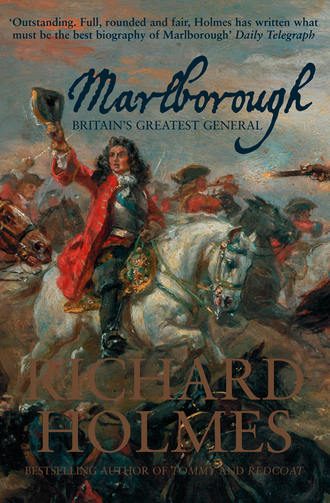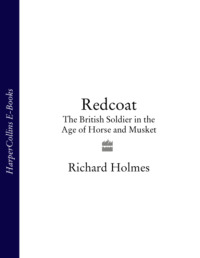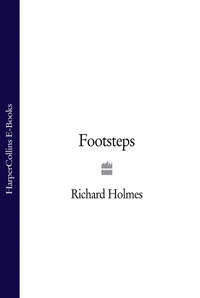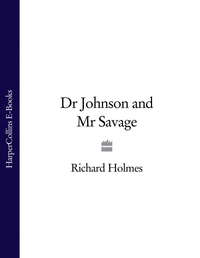
Полная версия
Marlborough: Britain’s Greatest General
The campaign was now reaching its climax. Monmouth’s first option had been to march straight for London, sustained as he hoped by a vast and unstoppable popular rising. When, disobligingly, this support failed to materialise, he sought to base himself on Bristol (whence he could communicate with supporters elsewhere in the country), strengthen and train his army, and only then head for the capital. With the swing away from Bristol his campaign had teetered beyond its culminating point, and he was fast running out of options. Feversham, for his part, had never planned to fight until his army was complete, and time was now on his side.
Poor scouting led the royal army, heading south on Monmouth’s heels, into an unplanned clash at Norton St Philip on 27 June. Its advance guard received a bloody nose, staunched only by the arrival of Churchill, who ‘secured the mouth of the lane with his dragoons and lined the hedges on each side with foot’, providing a secure base which enabled Feversham to extricate himself. Despite this brief setback, Feversham remained determined to maintain close contact with Monmouth, whose army, suffering the effects of repeated bad weather and evident failure, was haemorrhaging deserters. Monmouth briefly considered trying to sidestep Feversham by making for Warminster and then heading for London, but Feversham got wind of this from sympathisers and deserters, and marched from Bradford on Avon early on 29 June to block the rebels’ route at ‘Westbury under the Plain’.
The train of artillery at last arrived on the thirtieth, and Feversham then edged south-westwards, gently shadowing Monmouth, whose numbers shrank daily. On 4 July Churchill wrote to Lord Clarendon from Somerton. He was now evidently as anxious about his career as he was about the outcome of the campaign. He told Clarendon that:
nobody living can have been more observant than I have been to my Lord Feversham … in so much that he did tell me he would write to the King, to let him know how diligent I was, and I should be glad if you would let me know if he has done me that justice. I find, by the enemy’s warrant to the constables, that they have more mind to get horses and saddles than anything else, which looks as if he has a mind to break away with his horse to some other place and leave his foot entrenched at Bridgwater, but of this and all other things you will have it more at large from my Lord Feversham, who has the sole command here, so that I know nothing but what it is in his pleasure to tell me, so that I am afraid of giving my opinion freely, for fear it should not agree with what is the King’s intentions, and so expose myself. But as to the taking care of the men and all other things that is my duty, I am sure nobody can be more careful than I am; and as for my obedience, I am sure Mr Oglethorpe is not more dutiful than I am … 71
Oglethorpe, scion of a Yorkshire royalist family, also enjoyed the personal favour of James II. His conduct so far had kept him in Feversham’s eye, and at this juncture there was every chance that he would emerge with at least as much credit as Churchill. In the event Oglethorpe made significant mistakes at Sedgemoor but did indeed prosper. He stayed loyal to James in 1688 and refused to swear allegiance to William till 1696, thus destroying his military and political career. One of his sons, James Edward, went on to found the American state of Georgia; another, Lewis, was mortally wounded when Marlborough stormed the Schellenberg in 1704.
However, in 1685 all this lay in the future. When Churchill told Clarendon, ‘I see plainly that the trouble is all mine and the honour will be another’s,’ he was at least as suspicious of Oglethorpe as he was of Feversham. He was Feversham’s second in command, but was kept in the dark as to his plans, while the cavalry pursuit was entrusted to Oglethorpe, leaving Churchill with command of the foot. He was actually promoted major general in July, though he probably did not know of his good fortune till after Sedgemoor had been fought.
It was to Sedgemoor that Churchill’s steps now turned. While the royal army was at Somerton news arrived that the rebels were fortifying Bridgwater, where they had arrived on 3 July, as if they proposed to make their stand there. One of Feversham’s officers had ridden over the moor, and suggested that there was a good campsite on its edge, near the village of Westonzoyland. The royal army arrived there on Sunday, 5 July, and William Sparke, a local farmer, climbed the tower of Chedzoy church to see it moving into camp. He dispatched his herdsman, Benjamin Godfrey, to tell the Duke of Monmouth what had happened.72 The citizens of Taunton had firmly informed Monmouth that he would not now be welcome to return, and he had decided to march northwards once more, heading yet again for Keynsham bridge and Bristol. However, Godfrey’s news induced him to change his mind. He determined to mount a night attack on the royal army, interviewed Godfrey, and may well have spoken to William Sparke and climbed Chedzoy tower to see the ground for himself. So much of what happened that busy afternoon has become the stuff of legend, but one credible story has Monmouth spot the colours of Dumbarton’s Regiment, which had fought under his command in France and ‘by which he had been extremely beloved’. He told one of his officers, ‘I know these men will fight and if I had them I would not doubt of success.’73
The field of Sedgemoor is a squarish slab of tussocky lowland, each of its sides roughly three miles long. The Bussex Rhine, marking its south-east border, oozed into the River Parrett, its south-west edge, two miles from Westonzoyland. North-east of the village the Bussex Rhine joined the Black Ditch, the north-eastern boundary of the battlefield. The smaller Langport Rhine curled out like a comma from the Black Ditch just south of the cornfields bordering Chedzoy. The main road to Bristol from Bridgwater, marking the north-west edge of the field, ran across the moor via the ‘Long Causeway’. Just over two miles from the town the ‘Short Causeway’ carried a track to Chedzoy, out on the moor. Another metalled road curled from Westonzoyland to Bridgwater by way of Panzoy Farm.
On 4 July Captain Coy’s troop of the Royal Dragoons flicked forward towards Bridgwater, met a strong body of Monmouth’s horse and got off ‘without any considerable damage on either side’. Feversham seems to have believed that the main body of the rebels would stand siege in Bridgwater, for he sent word to Bath to hasten the arrival of his ‘mortar piece’, no real use to him in the field but able to pitch its explosive shells over walls. His men went into camp just north of Westonzoyland, with the Bussex Rhine between them and Bridgwater, a little over three miles away. Recent research suggests that the Bussex Rhine was perhaps eight and a half metres wide but, in the area of the battlefield, only thirty centimetres deep. Much bigger rivers have had less momentous consequences.
Feversham’s infantry pitched their tents in a single line behind the Bussex Rhine, leaving enough ground between camp and ditch for them to form up in line of battle. The cannon were on the infantry’s left, ‘fronting the great road’ to make it easier to get them on the move again next morning, and the horse and dragoons were quartered in Westonzoyland. The official account of the battle emphasises the trouble that Feversham took to guard against surprise. Captain Coy’s dragoons watched the crossings of the River Parrett at Barrow Bridge and Langport to the army’s left rear. The road to Bridgwater was soundly
picketed. Captain Upcott of the Oxford Blues had a ‘grand guard’ of forty troopers, essentially a stationary sentry-party, out on the moor beyond Panzoy Farm. There were forty musketeers of the Foot Guards behind the walls of a sheep fold (‘walled man-high’) further towards Bridgwater, with plenty of sheep ticks and few opportunities for tow-row-rowing. Finally, a party of a hundred men of the Blues and fifty dragoons under Lieutenant Colonel Sir Francis Compton was further forward still, providing sentries and small patrols to screen the moor and able to fall back onto the musketeers and the cavalry grand guard if they came under pressure.
Given Feversham’s assumption, shared by Churchill, that the rebels might try to get their horse away, probably to the north, Theophilus Oglethorpe had put a small patrol out onto the Bridgwater – Bristol road, and posted another party on the Langmoor Rhine, and then rode up to the top of Knowle Hill. Feversham visited ‘his sentries, together with his grand and out guards’, at about eleven and then retired to his quarters in Westonzoyland, where he was to sleep on a camp bed set up in the parlour at Weston Court. He had every reason to turn in with confidence: perhaps 250 of his seven hundred horse and dragoons were now on duty, and he had taken all reasonable precautions against surprise.
His infantry battalions were camped in order of seniority. Dumbarton’s was the senior line regiment in the field but junior to the guards regiments present, two battalions of 1st Foot Guards and a single battalion of the Coldstream.74 However, Dumbarton’s took station at the post of honour on the right of the line, almost certainly because it furnished the infantry grand guard, with perhaps a hundred of its soldiers standing to their arms all night. This party would provide the little force’s right markers if the infantry had to assemble during the night. The vicar of Chedzoy maintained that one of Dumbarton’s company commanders was sure that the rebels would attack, and had paced out the ground between tents and Bussex Rhine and warned his men to be ready.
There seems, however, to have been little sense that there was any real danger. Edward Dummer, a gunner in the artillery train, recorded that ‘a preposterous confidence of ourselves with an undervaluing of the rebels that many days before had made us make such tedious marches had put us into the worst circumstances of surprise’. Writing in 1718, an officer of the Blues declared that ‘On Sunday night most of the officers were drunk and had no manner of apprehension of the enemy.’75 We may doubt whether a tiny village like Westonzoyland actually contained sufficient alcohol to induce widespread drunkenness, even if the royal army was unfamiliar with the foot-tangling attributes of the local cider. But it is safe to assume that, apart from the occasional edgy Scot, most of Feversham’s officers yawned confidently to their beds.
Monmouth’s army moved out of Bridgwater on the Long Causeway at about eleven o’clock that night. It did not take the Short Causeway out to Chedzoy, the easiest route onto the moor, but turned eastwards in the direction of Peasy Farm to march parallel with the Black Ditch towards the royal army’s right flank. Theophilus Oglethorpe, up on Knowle Hill and preoccupied with the Bristol road, saw nothing of this. To make matters worse, after dark he had pulled in his standing patrol from the Langmoor Rhine, leaving a gap through which Monmouth slipped. He discovered what had happened some time later, when he took a patrol towards Bridgwater to satisfy himself that the rebels were still there. He just missed the tail end of Monmouth’s marching army, and only when he reached Bridgwater did he learn that the rebels had left the town.
At about the same time that Oglethorpe realised the scale of his failure, Monmouth was getting his men across the Langmoor Rhine, and confirming his plan with his senior commanders. Lord Grey was to take the cavalry over the northern plungeon (ford) over the Bussex Rhine, swing round into Westonzoyland and spread havoc through the royal camp. The infantry, marching onwards in column, would halt opposite the royalist foot, turn left into line, and attack a camp already rocked by the irruption of the rebel horse. It was not a bad plan, and even in the small hours of 6 July it might still have worked. However, as the rebels picked their way over the Langmoor Rhine in the misty half-light, a shot rang out.
We cannot be sure who fired it. Captain John Hucker of Monmouth’s horse maintained at his trial that he shot deliberately, to betray the attack, but his tale was as unconvincing then as it is now, and they hanged him anyway. It was probably one of Compton’s troopers, out creasing the moor, who fired his pistol in the air the minute he saw columns of rebel infantry on the move, and then rode towards Chedzoy to find Compton himself. Compton sent at least one trooper to camp to raise the alarm, and as he spurred towards Westonzoyland he collided with part of the rebel horse. Lord Grey had predictably missed the northern plungeon and had turned north of the Bussex Rhine rather than south of it, so was now separated from the royal camp by a belt of water which was effectively impassable to poorly trained cavalry in the dark.76 There was an inconclusive scuffle in which Compton was shot in the chest, but the damage was done.
Behind the Bussex Rhine the king’s infantry had turned out of their tents to form up on the open ground south of the ditch. Their drums were now beating. Some regiments had been issued with new flintlock fusil, but others had the older matchlock, and the glow of match-cord flickered out along the line as the corporals, whose job it was to keep a light handy, lit their men’s matches. The official account tells of ‘my Lord Churchill having command of the foot and seeing every man at his post doing his duty’, and the infantry’s swift response to the alarm speaks loudly for its training and discipline, and his precautions. All chance of surprise, and with it Monmouth’s battle, was now lost.
Most of Grey’s horsemen crossed Dumbarton’s front unengaged by yelling out that they were militia horse under Albemarle. But when challenged by 1st Foot Guards (commanded by Monmouth’s half-brother the Duke of Grafton), some replied with the rebel field-word ‘Monmouth and God with us,’ and both battalions of 1st Foot Guards in turn replied with a volley, as did the right-hand companies of the Coldstream. This was too much for Grey’s men, who broke back across the moor, some of them colliding with the two rearmost regiments of foot, the Blue and the White, which were forming up after crossing the Langmoor Rhine. The three remaining regiments, Red, Yellow and Green, managed to get into line ‘but not in good order’, just across the Bussex Rhine from the royal army’s right flank.
The rebel gunners had trundled three small field guns all the way from Bridgwater, and now swung them into action between the Yellow and Green regiments towards the left of Monmouth’s line. The rebels got to within ‘half musket shot’ of their enemies (Nathaniel Wade thought that the Red Regiment was within thirty or forty paces of the Bussex Rhine), stood their ground, and fired. Monmouth’s cannon, manned by Dutch professionals, made better practice than his infantry, most of whom, like many soldiers in battle for the first time, shot too high. Sending blasts of case-shot across the Bussex Rhine, the guns were soon doing serious damage to Dumbarton’s men and the right-hand battalion of 1st Foot Guards. Churchill, having satisfied himself that his line was properly drawn up, sent one troop of the Royal Dragoons across to the southern plungeon, and directed Lord Cornbury to take two more across to the right to support Dumbarton’s. He also ordered three light field guns to take station on the right of Dumbarton’s and pushed another three forward to join the first battalion of 1st Foot Guards. There is a pleasing story that Dr Peter Mews, Bishop of Winchester, a Dorset man who was accompanying the army, used his carriage horses to tug at least one of the guns into action. He had been a royalist captain during the Civil War and had fought in Holland after it, and was just the sort of prelate who saw no harm in praising God and passing the ammunition, but it is impossible to confirm the tale.
Cornbury’s dragoons, probably dismounted, were in action against the Green regiment on Monmouth’s left. They hit its colonel, Abraham Holmes, killing his horse beneath him and leaving him badly wounded on the ground. Churchill crossed the ditch nearby when the infantry eventually moved forward and asked Holmes, ‘Who art thou?’ Holmes replied glumly that he was not in a condition to tell. By this time some of the royal horse had mounted and ridden out of Westonzoyland to attack the right flank of Monmouth’s infantry. There is a possibility that they missed their way in the dark, swung back too close to the royal line and were duly shot at by their own infantry, but we cannot be sure.
When Feversham reached the field he divided his horse into two groups, and sent them out across the two plungeons to threaten the rebel flanks, probably ordering them not to charge until it was light enough for them to see what they were doing. Oglethorpe, on the right, spurred on anyhow, collided with a party of rebel horse and was then beaten off with loss when he charged one of the rebel foot regiments. While the horse were getting out onto the moor, Churchill shifted Trelawney’s and Kirke’s, who had nothing to shoot at, across to the right, although by the time they came up with Dumbarton’s the sun was beginning to rise and the battle was entering its last phase. With daylight reducing the risk of further ‘friendly fire’ incidents the royalist horse charged the retreating rebel infantry. The guns were swiftly overrun, and the rebel foot, struggling off as best it could, was soon swamped. Churchill quickly pushed the grenadier companies of his infantry across the Bussex Rhine to support the horse. The grenadiers of Dumbarton’s took Monmouth’s own banner, whose motto Fear nothing but GOD might have seemed ironic to the rebel survivors now running for their lives to escape the broadswords of the pursuing horsemen.
Oglethorpe was sent post-haste to London with news of the victory: his mistakes had not cost him Feversham’s favour. Churchill rode straight for Bridgwater, which opened its gates at once. The settling of accounts began early: on 7 July a Dutch gunner and a deserter who had fought for the rebels were hanged in front of the whole army. That hard man Percy Kirke, now appointed brigadier to command both his own regiment and Trelawney’s, was left behind to secure prisoners and ensure that the dead were properly buried. Sedgemoor had cost the royal army about thirty killed, and another 206, most of them from Dumbarton’s and 1st Foot Guards, were to receive pensions for wounds received. At least 1,400 rebels had been killed in the fighting and pursuit.
Monmouth was captured, dressed in shepherd’s clothes, on 8 July. He had already been condemned by Act of Attainder, but cravenly begged the king for his life: James observed that he ‘did not behave himself so well as I expected nor as one ought who had taken upon him to be king’.77 He had recovered his courage by the time he was taken to Tower Hill for execution the next day but, despite a substantial tip of six guineas, with the promise of another six from a servant after the job was done, Jack Ketch, the executioner, failed to kill him with his first three hacks. He then threw down his axe and declared that he could not go on, but the furious crowd urged him to put Monmouth out of his misery. Another two blows failed to sever the duke’s head, and the executioner eventually worried it off with his knife. Ketch had to be escorted from the scene to protect him from the mob.
The trials of captured rebels began at Winchester in late August, and thereafter the ‘Bloody Assizes’, supervised by George, Lord Jeffreys, the lord chief justice, worked its sanguinary way across the West Country. Something over three hundred rebels were hanged, drawn and quartered, their executions taking place across the region and their quartered bodies distributed even more widely. Almost nine hundred were sentenced to transportation to the West Indies as unpaid labourers for four years, a term of exile soon increased to ten years. Churchill’s biographers whisk him back to London immediately after the battle, but in late September Jeffreys wrote to tell the king that Churchill, ‘who was upon the place’, would tell him what had been done to snuff out rebellion in Taunton, a comment that makes sense only if Churchill had first witnessed Jeffreys’ bloody handiwork and then returned to London.78 The property of traitors was forfeit to the crown, and some of it was passed on as reward to the victors of Sedgemoor. Feversham, made a Knight of the Garter, received the estates of the executed Alice Lisle, and Churchill was given the very considerable property of John Hacker, captain of rebel horse and prosperous Taunton businessman.
Churchill emerged from the campaign with great credit. Of his possible rivals, Theophilus Oglethorpe had not fulfilled his promise as a cavalry leader, and Percy Kirke was to establish an unpleasant (though probably exaggerated) reputation for casual brutality as he snuffed out the embers of the rebellion with his tough Tangier veterans, known ironically, from their paschal lamb emblem, as Kirke’s Lambs. However, Churchill’s role in the battle became politicised almost immediately, and too many of his biographers have taken contemporary polemic for historical fact. Feversham, a royal favourite and a Frenchman by birth, was not popular at a time when the French were seen as natural enemies. His depiction in the Duke of Buckingham’s play The Battle of Sedgemoor (which manages to combine both anti-French and anti-Irish prejudice) is valuable only as evidence of perennial English suspicion of Johnny Foreigner.
A pox take de Towna vid de hard Name: How you call de Towna, De Breeche? … Ay begarra, Breechwater; so Madama we have intelegenta dat de Rebel go to Breechwater; me say to my Mena, Match you Rogua; so we marsha de greata Fielda, beggar, de brave Contra where dey killa de Hare vid de Hawk, beggar, de brav Sport in de Varld.79
Feversham was a naturalised Englishman, had lived in England for over twenty years, and spoke the language well.
Thomas Lediard’s whiggish biography of Marlborough (1736) quotes an unknown author who affirms that Feversham ‘had no parties abroad, he got no intelligence, and was almost surprised, and like to be defeated, when he seemed under no apprehension, but was abed without any care or order’. We have already seen how Feversham’s precautions were wholly professional. Had Oglethorpe not shifted the crucial picket Monmouth’s advance would have been detected sooner, but as it was Compton’s screen did precisely what was expected of it. The Reverend Andrew Paschall heard from a church official in Westonzoyland that an unnamed lord sought a local guide to take him away from the battle, but it is impossible to link this firmly to Feversham, though some have tried. There were repeated suggestions that Feversham, a Frenchman and thus by definition a fop, took a long time to dress after the alarm was given and insisted on breakfasting before leaving his quarters. The most that we can say is that he had been injured by a falling timber in one of the Whitehall fires and had subsequently been trepanned: this might have made it harder for his servants to wake him.
Winston S. Churchill claimed that:
Nothing could free the public mind from the fact that Churchill had saved and won the battle. The whole Army knew the facts. The officers included the Household troops, the Guards, and all the most fashionable soldiers about the court. They all said what they thought. Feversham’s martial achievements became a laughing-stock … The impression that this slothful foreigner was slumbering on his couch and that the vigilant Englishman saved the situation had more truth in it than the popular version of many historical events.80
If these well-placed officers did indeed know discreditable facts about Feversham, and trailed them about court, we may wonder why James appointed him to command his army in 1688 when the threat was infinitely more serious.
Feversham does not have to be a villain for Churchill to be a hero. Whatever the rumours of drunkenness or lack of vigilance, the royal infantry, his prime responsibility as the army’s second in command, was camped in good order with well-understood alarm drills, and Dumbarton’s provided an alert grand guard which established the right marker for its battle line. Once the fight was joined, Churchill shifted dragoons to both flanks, and paid special attention to his right, where Dumbarton’s Scots were under pressure. He moved his two left-hand regiments off to the right some time afterwards, but by this time the rebel attack was broken. John Tincey, whose recent scholarly account of Sedgemoor comes as close as we can hope to being definitive, reckons that: ‘By the time Feversham arrived the battle was won and he had little to do but, with the dawn, to organise the pursuit of a beaten enemy … Sedgemoor may not have been John Churchill’s most spectacular victory, but it must rightfully be considered to be his first.’81











